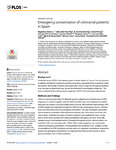Mostrar o rexistro simple do ítem
Emergency presentation of colorectal patients in Spain
| dc.contributor.author | Esteva, Magdalena | |
| dc.contributor.author | Ruiz-Díaz, Mercedes | |
| dc.contributor.author | Sánchez, María Antonia | |
| dc.contributor.author | Pértega-Díaz, Sonia | |
| dc.contributor.author | Pita-Fernández, Salvador | |
| dc.contributor.author | Maciá, Francecs | |
| dc.contributor.author | Posso, Margarita | |
| dc.contributor.author | González-Luján, Luis | |
| dc.contributor.author | Boscá-Wats, Marta M. | |
| dc.contributor.author | Leiva, Alfonso | |
| dc.contributor.author | Ripoll, Joana | |
| dc.date.accessioned | 2022-06-01T09:12:43Z | |
| dc.date.available | 2022-06-01T09:12:43Z | |
| dc.date.issued | 2018-10-01 | |
| dc.identifier.citation | Esteva M, Ruiz-Díaz M, Sánchez MA, Pértega S, Pita-Fernández S, Maciá F, et al. Emergency presentation of colorectal patients in Spain. PLoS One. 2018;13(10):e0203556 | es_ES |
| dc.identifier.issn | 1932-6203 | |
| dc.identifier.uri | http://hdl.handle.net/2183/30829 | |
| dc.description.abstract | [Abstract] Background. Colorectal cancer (CRC) is the leading cause of cancer deaths in Europe. Survival is poorer in patients admitted to hospitals through the emergency department than in electively admitted patients. Knowledge of factors associated with a cancer diagnosis through presentation at an emergency department may reduce the likelihood of an emergency diagnosis. This study evaluated factors influencing the diagnosis of CRC in the emergency department. Methods and findings. This is a cross-sectional study in 5 Spanish regions; subjects were incident cases of CRC diagnosed in 9 public hospitals, between 2006 and 2008. Data were obtained from patient interviews and primary care and hospital clinical records. We found that approximately 40% of CRC patients first contacted a hospital for CRC through an emergency service. Women were more likely than men to be emergency presenters. The type of symptom associated with emergency presentation differed between patients with colon cancer and those with rectal cancer, in that the frequency of “alarm symptoms” was significantly lower in colon than in rectal cancer patients who initially presented to emergency services. Soon after symptom onset, some patients went to a hospital emergency service, whereas others contacted their GP. Lack of contact with a GP for CRC-related symptoms was consistently related to emergency presentation. Among patients who contacted a GP, a higher number of consultations for CRC symptoms and any referral to outpatient consultations reduced the likelihood of emergency presentation. All diagnostic time intervals were shorter in emergency presenters than in elective patients. Conclusions. Emergency presenters are not a uniform category and can be divided into categories according to their symptoms, help seeking behavior trajectory and interaction with their GPs. Time constraints for testing and delays in obtaining outpatient appointments led patients to visit a hospital service either on their own or after referral by their GP. | es_ES |
| dc.description.sponsorship | Instituto de Salud Carlos III; PI052273 | es_ES |
| dc.description.sponsorship | Instituto de Salud Carlos III; PI050787 | es_ES |
| dc.description.sponsorship | Instituto de Salud Carlos III; PI050700 | es_ES |
| dc.description.sponsorship | Instituto de Salud Carlos III; PI052692 | es_ES |
| dc.description.sponsorship | Instituto de Salud Carlos III; PI052141 | es_ES |
| dc.description.sponsorship | Insituto de Salud Carlos III; RD06/0018 | es_ES |
| dc.description.sponsorship | Instituto de Salud Carlos III; RD12/0005/0011 | es_ES |
| dc.language.iso | eng | es_ES |
| dc.publisher | PLoS One | es_ES |
| dc.relation.uri | https://doi.org/10.1371/journal.pone.0207143 | es_ES |
| dc.rights | Atribución 3.0 España | es_ES |
| dc.rights.uri | http://creativecommons.org/licenses/by/3.0/es/ | * |
| dc.subject | Colorectal neoplasms | es_ES |
| dc.subject | Early detection of cancer | es_ES |
| dc.title | Emergency presentation of colorectal patients in Spain | es_ES |
| dc.type | info:eu-repo/semantics/article | es_ES |
| dc.rights.access | info:eu-repo/semantics/openAccess | es_ES |
| UDC.journalTitle | PLoS One | es_ES |
| UDC.volume | 13 | es_ES |
| UDC.issue | 10 | es_ES |
| UDC.startPage | e0203556 | es_ES |
Ficheiros no ítem
Este ítem aparece na(s) seguinte(s) colección(s)
-
INIBIC-ECB - Artigos [50]






